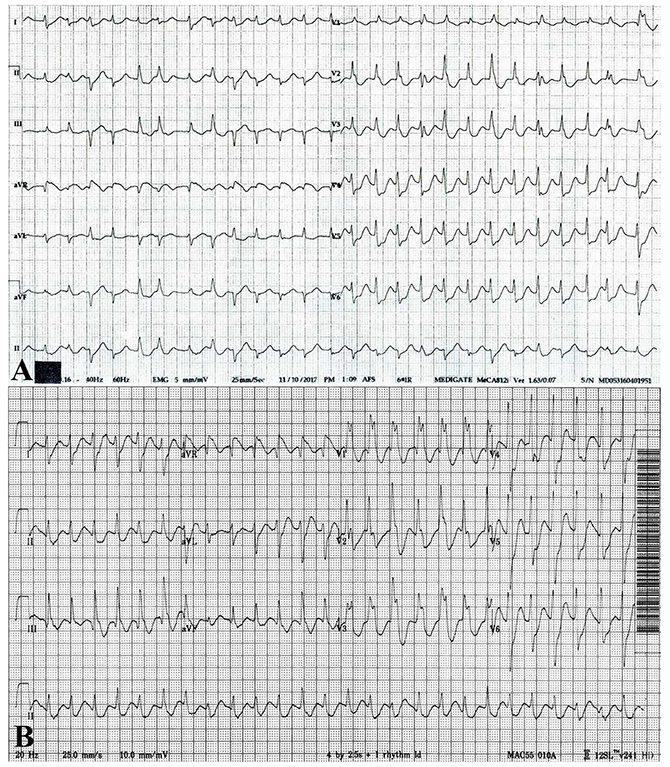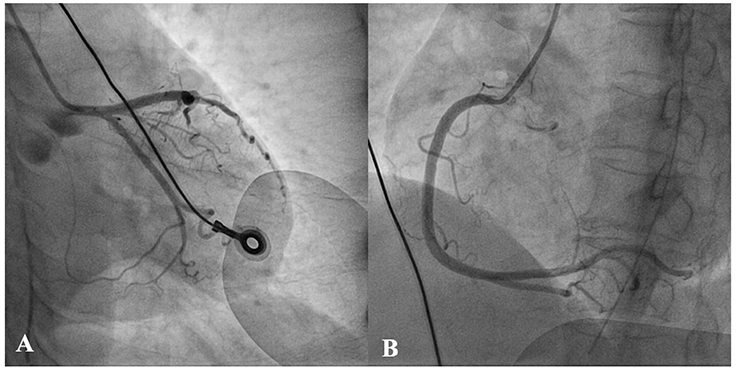Transl Clin Pharmacol.
2019 Jun;27(2):69-72. 10.12793/tcp.2019.27.2.69.
Electrical storm induced by hypokalemia associated with herbal medicines containing licorice
- Affiliations
-
- 1Division of Cardiology of Chosun University Hospital, Gwangju 61453, Korea. kholywater@gmail.com
- KMID: 2457574
- DOI: http://doi.org/10.12793/tcp.2019.27.2.69
Abstract
- A 60-year-old woman presented with polymorphic ventricular tachycardia secondary to hypokalemia, which necessitated dozens of DC cardioversions. She was not taking any other medication and denied any vomiting or diarrhea. Further investigation for hypokalemia suggested a hypermineralocorticoid state. Repeated inquiry prompted the patient to admit to taking herbal medicine containing licorice. She was treated with magnesium sulfate, potassium infusion, and intravenous lidocaine. A potassium-sparing diuretic was also prescribed. On the seventh day, the patient was discharged from the hospital with advice to discontinue taking herbal medicines containing licorice. She has been followed up at our outpatient clinic without further symptoms for 3 years. This case highlights the potential for cardiovascular complications associated with consumption of herbal medicines such as licorice. Clinicians should be aware that patients presenting to the emergency department with ventricular arrhythmia and uncertain hypokalemia should be questioned about licorice intake. Obtaining a detailed history from patients admitted to the hospital for electrical storm is essential.
Keyword
MeSH Terms
Figure
Reference
-
1. Farese RV Jr, Biglieri EG, Shackleton CH, Irony I, Gomez-Fontes R. Licorice-induced hypermineralocorticoidism. N Engl J Med. 1991; 325:1223–1227.
Article2. Walker BR, Edwards CR. Licorice-induced hypertension and syndromes of apparent mineralocorticoid excess. Endocrinol Metab Clin North Am. 1994; 23:359–377.
Article3. Kowey PR. An overview of antiarrhythmic drug management of electrical storm. Can J Cardiol. 1996; 12:Suppl B. 3B–8B.4. Cho S, Lim B, Cho H, Joung J, Choi Y, Kim D, et al. Licorice induced hypokalemia. Korean J Nephrol. 2001; 20:1021–1025.5. Seo SC, Eom MS, Park WU, Go HI. Licorice-induced hypokalemia and myopathy. Korean J Nephrol. 2006; 25:651–656.6. Kim BJ, Hong YH, Sung JJ, Park KS, Hyun CL, Choe GY, et al. A case of glycyrrhizin (licorice)-induced hypokalemic myopathy. J Korean Neurol Assoc. 2006; 24:389–391.7. Hong HI, Han KH, Hwang JW, Kim YD, Shim MS, Kim JY. A case of licorice induced hypokalemic paralysis with rhabdomyolysis. J Korean Soc Endocrinol. 2005; 20:179–182.
Article8. Panduranga P, Al-Rawahi N. Licorice-induced severe hypokalemia with recurrent torsade de pointes. Ann Noninvasive Electrocardiol. 2013; 18:593–596. DOI: 10.1111/anec.12076.
Article9. Miyamoto K, Kawai H, Aoyama R, Watanabe H, Suzuki K, Suga N, et al. Torsades de pointes induced by a combination of garenoxacin and disopyramide and other cytochrome P450, family 3, subfamily a polypeptide-4-influencing drugs during hypokalemia due to licorice. Clin Exp Nephrol. 2010; 14:164–167. DOI: 10.1007/s10157-009-0244-9.
Article10. Crean AM, Abdel-Rahman SE, Greenwood JP. A sweet tooth as the root cause of cardiac arrest. Can J Cardiol. 2009; 25:e357–e358.
Article11. Eriksson JW, Carlberg B, Hillörn V. Life-threatening ventricular tachycardia due to liquorice-induced hypokalaemia. J Intern Med. 1999; 245:307–310.
Article12. Oztürk S, Karaman K, Cetin M, Erdem A. Polymorphic ventricular tachycardia (torsades de pointes) due to licorice root tea. Turk Kardiyol Dern Ars. 2013; 41:241–244.
Article13. Park KA, Seok SJ, Kim SJ, Gil HW, Yang JO, Lee EY, et al. A case of licorice-Induced hypokalemic rhabdomyolysis in a patient using a diuretic drug. Korean J Med. 2011; 80:258–262.14. Størmer FC, Reistad R, Alexander J. Glycyrrhizic acid in liquorice--evaluation of health hazard. Food Chem Toxicol. 1993; 31:303–312.
Article15. Russo S, Mastropasqua M, Mosetti MA, Persegani C, Paggi A. Low doses of liquorice can induce hypertension encephalopathy. Am J Nephrol. 2000; 20:145–148.
Article16. Harahap IS, Sasaki N, Gunadi , Yusoff S, Lee MJ, Morikawa S, et al. Herbal medicine containing licorice may be contraindicated for a patient with an HSD11B2 mutation. Evid Based Complement Alternat Med. 2011; 2011:646540. DOI: 10.1093/ecam/nep211.



